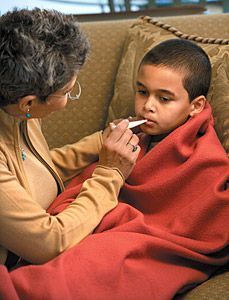Fever Facts for Parents
 Fever 101: When invaded by a virus, bacteria, or other pathogen, the brain recognizes the invader and raises the body temperature to kill it. Usually, the temperature raises only a couple degrees, but when the brain and immune system determine it necessary, body temperature may rise several degrees.
Fever 101: When invaded by a virus, bacteria, or other pathogen, the brain recognizes the invader and raises the body temperature to kill it. Usually, the temperature raises only a couple degrees, but when the brain and immune system determine it necessary, body temperature may rise several degrees.- are beneficial
- are best left alone to "run their course"
- resolve within 24-72 hours
- spike in the late afternoon or early evening
Defining a Fever: In children above 3 months of age, a fever is a good sign the immune system is working properly.
- text book "normal" = 98.6° F
- low fever = 100°-102.2° F
- moderate fever = 102.2-104.5° F
- high fever = 104.5°-108° F
- serious fever > 108° F
Both low and moderate fevers are beneficial as they kill pathogens. High fevers are usually indicative of a bacterial infection, and while they do not cause harm, assistance from a health care provider is recommended.
The brain carefully regulates body temperature and only exteme environmental stress - for instance, if a child is left in a closed car in hot weather - leads to a temperature above 108° F. A serious fever can be harmful. You should seek medical attention immediately.
Fever Reducers: The American Academy of Pediatrics does not recommend fever-reducing drugs, even for high fevers: "Fever is not an illness, rather, it is a symptom of sickness and is usually a positive sign that the body is fighting infection."
In fact, fever-reducing medication such as acetaminophen (Tylenol), ibuprofen, and aspirin can cause liver damage, stomach upset, and other health problems.
The Best Response: The best response to fever below 104.5° is rest and clear fluids. You should contact your health care provider if
should contact your health care provider if
 should contact your health care provider if
should contact your health care provider if- a child younger than 3 months has a fever
- a child 3 months - 3 years has a temperature above 102.2° F and appears ill
- a child of any age has a temperature about 104.5° F
In addition, watch for signs of dehydration including
- dry mouth
- lack of urine or wet diapers for 6-8 hours
- dry skin
- lethargy, irritability, fatigue, dizziness
Dr. Tickel's comment: An easy way to remember the above information is to know the
Fever Rules of 3:
- Under 3 months, seek medical attention
- Under 103°, seek attention from a conservative health care provider, such as a chiropractor. The child may need 2-3 adjustments/day.
- Over 103°, seek medical attention
- If a fever last more than 3 days, seek medical attention
 As a mom: In January 2012 my daughter, 20 months old, was sick with a low fever, sinus infection, and double pink eye. Concerned, and I must admit, slightly panicked, I took her to a pediatrician who confirmed my diagnosis and added double ear infection. As most pediatricians would, she prescribed an antibiotic and Tylenol.
As a mom: In January 2012 my daughter, 20 months old, was sick with a low fever, sinus infection, and double pink eye. Concerned, and I must admit, slightly panicked, I took her to a pediatrician who confirmed my diagnosis and added double ear infection. As most pediatricians would, she prescribed an antibiotic and Tylenol.
Leaving the office upset that I would have to "give in" and give my daughter (Adriana) drugs, I instead took her to a premier chiropractic pediatrician. She confirmed all four diagnoses, adjusted Adriana, recommended high dose vitamin C and an anti-viral homeopathic remedy, and told me several at-home, all natural remedies. When I took her for a follow up visit the next day, the ear infection and fever were already completely resolved. While it took 2 more days for the pink eye and sinus infection to clear, I never filled the antibiotic prescription and never resorted to Tylenol.
Closing comments: Children get sick, they're supposed to - it's how the body builds immunity. If we medicate our children to prevent sickness, the immune system will not develop properly and lead to problems such re-current ear or sinus infections, allergies, and more serious diseases like cancer later in life.
That doesn't mean, however, that we need to sit by and watch our children suffer. Getting quality chiropractic care, taking the appropriate supplements, and investigating natural at-home remedies can speed recovery and help both child and parent feel better during the process.